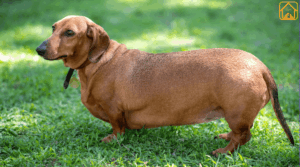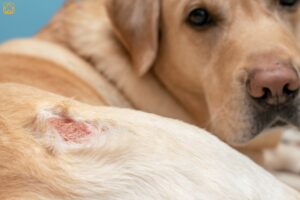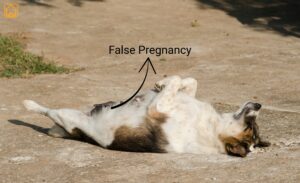Understanding Hip Problems in Dogs
Hip problems in dogs affect the joint that connects the thigh bone (femur) to the pelvis. This joint works like a ball and socket, allowing your dog to run, jump, and play with ease, when everything’s working right. But when there’s a problem, even simple movements can become painful.
These issues aren’t limited to large breeds or older dogs. While breeds like Golden Retrievers, German Shepherds, and Labradors Retrievers are more prone to hip issues in dogs, even smaller pups can be affected. Hip problems can develop due to genetics (like canine hip dysplasia), injuries, or even lifestyle factors.
Common Types of Canine Hip Disorders
There are several hip disorders in dogs, but some stand out as the most common:
Hip Dysplasia
A hereditary condition where the ball and socket don’t fit together properly. Over time, this causes joint looseness, arthritis, and pain. “Dogs and hip dysplasia” is one of the most searched topics for a reason, it’s widespread, especially in large breeds.
Hip Dislocation & Hip Displacement
Sometimes, dogs experience the hip joint partially (displacement) or fully (dislocation) slipping out of place. This might be due to trauma, but in many cases, it’s a consequence of chronic laxity from dysplasia. Dislocation is acutely painful and demands emergency care.
Osteoarthritis (Degenerative Joint Disease)
Over time, any chronic hip issue can result in Osteoarthritis. The cartilage wears down, bone spurs develop, and pain/stiffness set in. Arthritis is often the end stage of untreated or advanced dysplasia and is a leading cause of mobility loss in senior dogs.
Legg-Calvé-Perthes Disease
Seen mostly in small breeds, this is a rare condition where the femoral head deteriorates, causing pain and limping.
Each condition has its own treatment path, but all require attention. I once met a rescue pup with severe dysplasia, with the right therapy, he was chasing tennis balls again in a few months.
Causes and Risk Factors of Hip Issues in Dogs
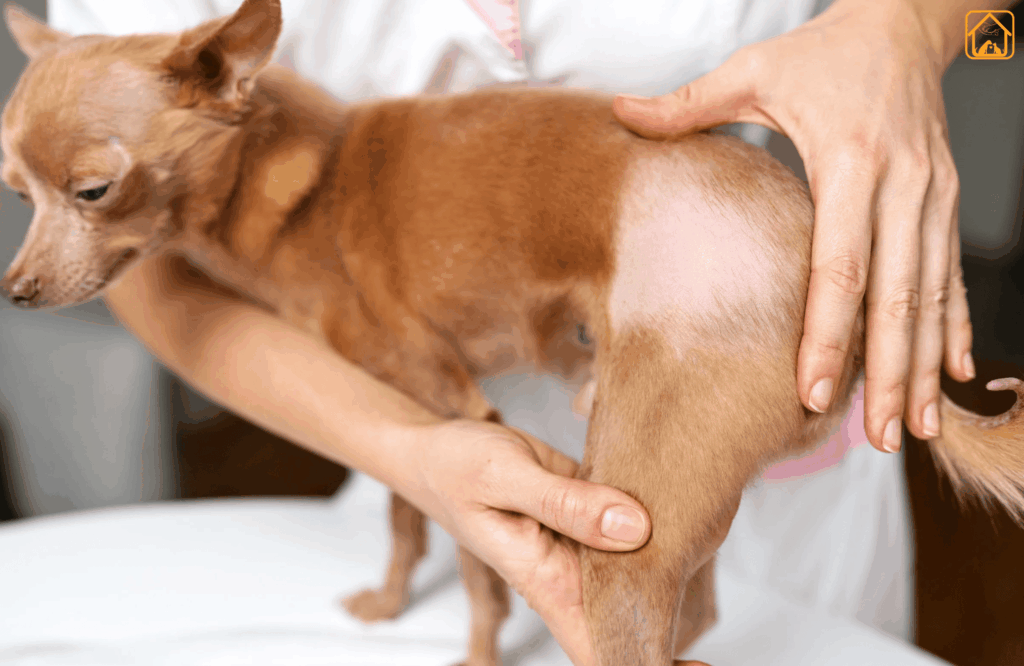
1. Genetics: The Main Player in Canine Hip Dysplasia
Hip dysplasia and many other hip issues in dogs are strongly genetic. If a puppy’s parents or grandparents had hip problems, there’s a much higher chance the pup will develop them, too. That’s why responsible breeders use X-rays and screening tests to select dogs with healthy hips for breeding.
2. Rapid Growth and Nutrition
Puppies that grow too fast, especially large and giant breeds like German Shepherds, Labrador Retrievers, Golden Retrievers, Rottweilers are more likely to develop loose, unstable hip joints. Overfeeding and calorie-rich diets speed up growth, putting extra stress on developing bones. Balanced nutrition and slow, steady growth (with special puppy food for large breeds) help lower the risk.
3. Obesity and Overweight Dogs
Carrying extra pounds means extra load for those hips, especially in breeds already prone to joint issues. Obesity doesn’t cause hip dysplasia directly, but it can make symptoms appear earlier and worsen arthritis.
4. Exercise: Too Little or Too Much
It’s all about finding the right balance. Too little activity can leave your dog’s hip muscles weak, while too much rough play or jumping especially in young pups can hurt developing joints. Gentle play, short walks on a leash, and avoiding high jumps are safest for puppies and breeds prone to hip issues.
5. Trauma and Injury
A fall, a sudden accident, or even rough play can cause serious hip injuries like dislocation, fractures, or torn ligaments. In some cases, an old injury that didn’t heal properly can come back later as arthritis or long-term hip trouble, making it harder for your dog to move comfortably.
6. Hormonal and Developmental Factors
There’s evidence that early spaying or neutering might slightly increase the risk of hip dysplasia in some large breeds. The exact link isn’t clear, but hormones affect bone and joint growth during puppyhood.
| Risk Factor | Affected Dogs | Prevention Tips |
| Genetics | All breeds, especially large | Choose breeders who screen for hip health |
| Rapid Growth | Large breed puppies | Feed properly-formulated puppy food, avoid overfeeding |
| Obesity | Any dog | Keep dogs at a lean, healthy weight |
| High-Impact Injury | Active dogs, all ages | Supervise play, avoid hazardous environments |
Recognizing the Symptoms: Early Signs of Hip Problems
Spotting early signs of hip problems in dogs can make a huge difference. The sooner you notice and act, the better the chances of recovery and improvement. Hip issues can show up in puppies, adults, or seniors often with changes that are easy to miss.
Common Signs of Hip Problems in Dogs
- Limping or Lameness: Your dog may suddenly start limping or show signs of favoring one or both back legs. You might notice them shifting more weight to the front or avoiding pressure on their hind legs.
- Stiffness: Getting up after a nap or first thing in the morning may seem tough. Your dog might move slowly or appear stiff after play or a walk.
- Bunny Hopping Walk: Watch for a hopping motion where both back legs move together instead of one at a time, especially when running or climbing stairs.
- Trouble Getting Up or Lying Down: If your dog hesitates before standing, takes longer to lie down, or changes positions often, it could be due to discomfort in the hips.
- Avoiding Usual Activities: If your pup used to love jumping on the couch, running up stairs, or chasing toys but now seems hesitant or uninterested, joint pain may be the reason.
- Thinning Muscles: You might notice their back legs looking slimmer or weaker over time. Muscle loss in the hind legs can happen when movement becomes painful.
- Sensitive to Touch: Some dogs may flinch, yelp, or even growl if you touch their hips. This kind of reaction usually points to pain or discomfort.
- Odd Sitting Posture: Look out for strange sitting positions, like sitting with one leg sticking out or both legs splayed. It often signals hip or joint issues.
Early vs. Advanced Symptoms
- Some puppies show signs as early as 4-6 months old; others may not display symptoms until middle or old age.
- Early symptoms can be subtle stiffness, mild limping, or reluctance to play.
- Advanced cases may present with severe lameness, constant pain, or even inability to walk.
The earlier you spot hip problems in dogs, the better the outcome. So, what are the first signs of hip problems in dogs?
- Limping or stiffness after rest or play
- Difficulty rising, climbing stairs, or jumping
- “Bunny-hopping” gait (moving both back legs together)
- Reluctance to exercise or play
- Loss of muscle mass in the hind legs
- Hip pain or sensitivity when touched
- Abnormal sitting positions
I remember thinking my dog was just “slowing down” with age, turns out, she had early-stage hip dysplasia. Trust your gut if you sense something’s off. Sudden hip problems in dogs, especially after a fall, need urgent veterinary attention.
Diagnosis: How Vets Identify Hip Disorders
Vets use a combination of physical exams and imaging to diagnose hip problems in dogs. During the exam, the vet will:
1. Detailed History and Physical Examination
- Your vet will ask about your dog’s breed, age, activity, diet, and symptoms. When did you first notice the issue? Is it getting worse?
- They’ll perform a thorough exam, watching your dog walk, stand, sit, and move. Manipulating the hips can reveal pain, stiffness, grating (crepitus), reduced range of motion, or joint looseness (laxity).
- Special physical tests, like the Ortolani sign, help detect hip laxity, an early sign of dysplasia.
2. Imaging: X-rays (Radiographs)
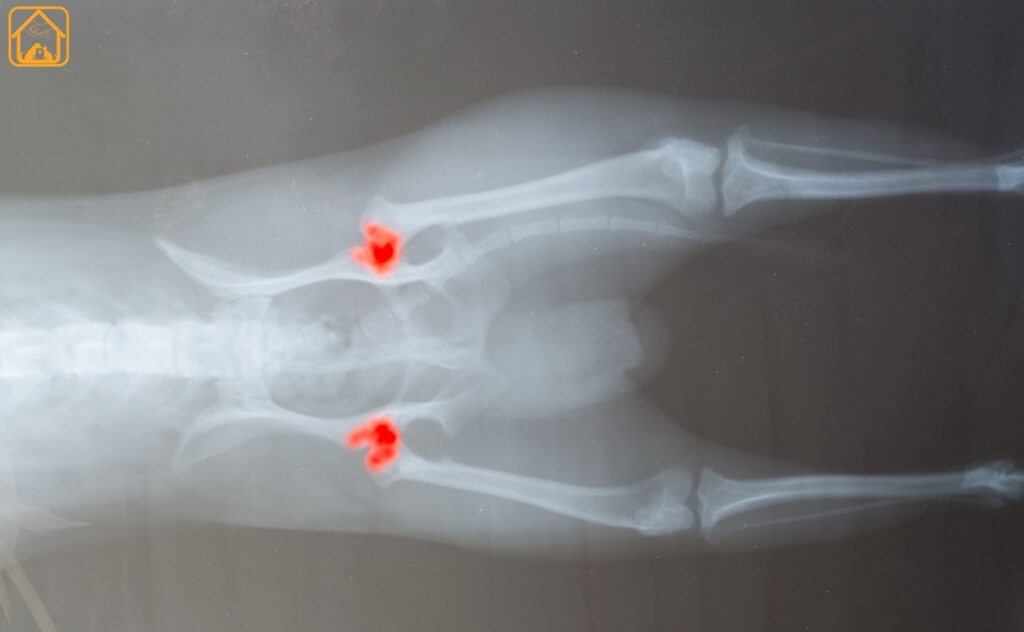
- X-rays are the gold standard for diagnosing hip dysplasia, displacement, dislocation, and arthritis. They show the shape, alignment, and any degenerative changes in the joint.
- In most cases, dogs need to be sedated or anesthetized to obtain clear, properly positioned images.
- Your vet may recommend specialty views (hip-extended, distraction, or compression views) to assess joint laxity and damage accurately.
3. Advanced Imaging (if needed)
- CT scans or MRI may be used in complex cases, especially before surgery or if other joint/tissue problems are suspected.
4. Hip Scoring and Screening Programs
- For breeding dogs, programs like OFA (Orthopedic Foundation for Animals), PennHIP, and BVA/KC (UK) assess hip quality and risk of dysplasia. These scores help responsible breeders reduce inherited hip problems in dogs.
- PennHIP can screen puppies as young as 16 weeks, while OFA typically scores dogs at 2 years or older.
5. Additional Tests
- Bloodwork may be done to rule out infection or inflammatory disease, especially if symptoms are unusual.
- Joint fluid analysis is rarely needed, but may be used if infection or immune-mediated disease is suspected.
Honestly? Seeing those x-rays for the first time can be overwhelming. But getting a clear diagnosis is the first step toward helping your pup feel better.
Treatment Options for Dog Hip Problems
If your dog has hip dysplasia, there are many ways to help like medications, physical therapy, and even surgery. Below are the detailed explanation.
Non-Surgical Management
For many dogs, the first step is easing their discomfort and reducing inflammation. This not only helps them feel more comfortable, but also protects their joints from getting worse over time.
- Weight Management: Keeping your dog at a healthy weight reduces joint stress and is crucial for managing hip disorders in dogs.
- Exercise: Controlled activity, like short walks and swimming, helps maintain muscle strength without overloading the hips.
- Physical Therapy: Rehab exercises and massage can boost mobility and comfort, many cities now have canine rehab specialists!
- Medications: Non-steroidal anti-inflammatory drugs (NSAIDs) and pain relievers, prescribed by your vet, ease discomfort. Glucosamine and chondroitin supplements may help support joint health. Some vets recommend polysulfated glycosaminoglycan injections for added benefit.
- Joint Diets: Special veterinary diets rich in omega-3 fatty acids and antioxidants can reduce inflammation.
- Alternative Therapies: Acupuncture and laser therapy can help some dogs with chronic pain.
Surgical Options
Sometimes, despite best efforts, medical management just isn’t enough. Surgery becomes the next step, especially in severe cases or when quality of life is at risk. There are several surgical treatments for hip problems in dogs:
- Total Hip Replacement (THR): The gold standard for severe hip dysplasia. The damaged joint is replaced with a prosthetic, restoring near-normal function. It is a bit costly, but can be life-changing for your dog.
- Femoral Head Ostectomy (FHO): The “ball” of the hip is removed, creating a false joint. This surgery doesn’t restore normal anatomy, but many dogs become pain-free and active, especially smaller breeds.
- Triple Pelvic Osteotomy (TPO): Performed in young dogs, this procedure realigns the hip socket to provide better coverage of the ball, preventing further damage.
- Juvenile Pubic Symphysiodesis (JPS): Done in puppies, this involves fusing part of the pelvis to encourage the socket to develop more fully.
The right treatment depends on your dog’s age, health, and how advanced the hip problem is. Your vet will guide you through options available based on your dog’s daily quality of life. I’ve seen older dogs thrive after a simple change in exercise routine, while others needed surgery for relief.
Home Remedies & Supportive Care for Hip Dysplasia
Hip dysplasia in dogs cannot be cured at home. While you can’t “cure” hip dysplasia at home, there are several ways to help your dog feel better:
- Orthopedic Beds: Provide extra joint support and comfort.
- Non-Slip Rugs: Prevent slipping and help your dog move confidently, especially on slick floors.
- Gentle Massage: Eases stiffness and encourages blood flow. (Ask your vet or a canine therapist for tips!)
- Heat Packs: Applied with care, these can soothe sore hips, but always check temperature first to avoid burns.
- Homeopathic Remedies: Some pet parents explore homeopathic remedies for hip dysplasia in dogs, but always consult your vet before trying new supplements.
- Dietary Support: Omega-3 fatty acids (like fish oil) may reduce inflammation in dog hips. Again, check with your vet for correct dosing.
One of my favorite “quick wins” was switching to a raised feeding station, my dog stopped straining her hips to eat. Small changes can make a big impact!
Preventing Hip Problems in Dogs: Breeding, Nutrition, & Lifestyle Tips
Prevention is always easier than treatment. To help avoid common hip problems in dogs:
- Choose breeders who screen for canine hip dysplasia and only breed healthy dogs.
- Feed large-breed puppies special formulas to support controlled growth and healthy joints.
- Keep your dog at a healthy weight. Avoid overfeeding. Too much rapid growth can lead to joint problems.
- Start joint supplements early in at-risk breeds (with vet guidance).
- Provide regular, low-impact exercise like swimming or leash walks.
- Avoid jumping from high places or overexertion in young dogs.
FAQs About Hip Problems in Dogs
What causes hip problems in dogs?
Hip problems are often caused by genetics (especially in purebreds), rapid growth, obesity, improper nutrition, or injury. Canine hip dysplasia is hereditary but can be worsened by environmental factors.
What are the first signs of hip problems in dogs?
Early signs include limping, stiffness after rest, bunny-hopping gait, reluctance to jump, and difficulty rising. Some dogs may simply seem less playful or energetic.
Can hip problems in dogs get better on their own?
Hip disorders rarely resolve without intervention. Early treatment (medical or surgical) and supportive care can greatly improve comfort and mobility, but professional advice is crucial.
What is the best medicine for hip dysplasia in dogs?
NSAIDs, prescribed by a vet, are commonly used for pain and inflammation. Supplements like glucosamine and chondroitin can support joint health. Never give human pain medication to dogs without veterinary approval.
Are there home remedies for hip dysplasia in dogs?
Supportive care, like orthopedic beds, non-slip flooring, and gentle massage, can help but it can’t be cured at home. Some owners try home remedies or homeopathic options, but always consult your vet before using new products.
How long can a dog live with hip dysplasia?
Many dogs with hip dysplasia live long, happy lives with the right management. Quality of life depends on early diagnosis, weight control, and treatment choices.
How much does hip surgery cost for dogs?
The cost varies widely, from Rs. 50K to 1 Lakh in India and abroad it will be $1,500 to $7,000 or more, depending on the procedure, location, and dog size. Your vet can give a detailed estimate based on your dog’s needs.
Can you prevent hip problems in dogs?
While you can’t eliminate risk entirely, choosing a responsible breeder, providing a healthy diet, managing weight, and giving regular, moderate exercise all help reduce the chance of hip problems.
What breeds are most at risk?
Large breeds like German Shepherds, Labradors, Golden Retrievers, Saint Bernards, and Rottweilers are at higher risk for canine hip problems. However, any dog can develop hip disorders.
When should I see a vet about my dog’s hips?
If you notice lameness, pain, reluctance to move, or any sudden change in mobility, schedule a vet visit right away. Early diagnosis leads to better outcomes.
Conclusion
Caring for a dog with hip problems can be challenging, but with the right support, your pup can still live a happy, active life. Early signs like limping or stiffness shouldn’t be ignored, quick action can prevent further damage.
From gentle exercise to surgery, there are many ways to manage hip issues. Every dog is different, so work closely with your vet to find the best approach. With patience, care, and a few thoughtful adjustments, you can ease your dog’s discomfort and keep their tail wagging for years to come.

